|
Monday, May 7, 2012
Progress Notes
In last weeks’ Progress Notes I featured a smart card video of the George Bear Family display in our museum which Brice Kallenbach had found in the grass of our museum campus. As I noted last week, we don’t know to whom it belonged, but the date indicated it had been lost since last April. If you didn’t see it last week here it is again (video 01):
Coincidentally, last week Patsy Luebbert and Jill Hartke from the State Historical Society of Missouri at Columbia came to our museum to copy the George Bear family photographs which are located in the display (photo 02).
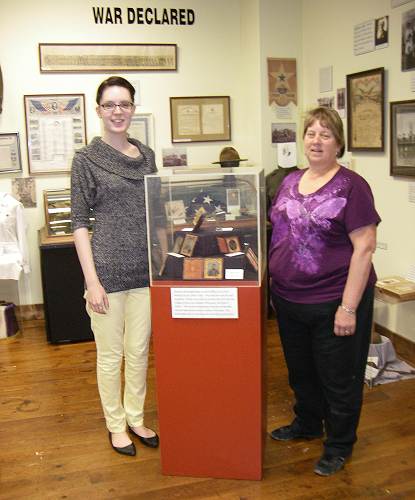
02 Jill Hartke and Patsy Luebbert
Patsy and Jill were especially interested in the Bear family photos because six of George Bear’s sons fought for the Union in the Civil War. Here are photos of the six Bear brothers (photos 03 - 08):
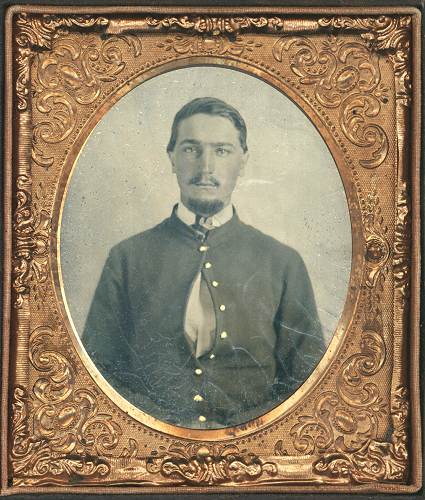
03 John Bear 1814-1912
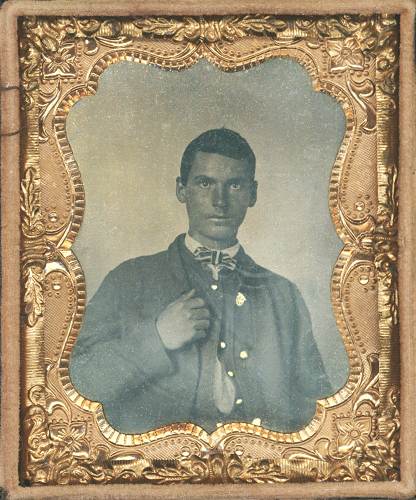
04 Henry Bear 1827-1932
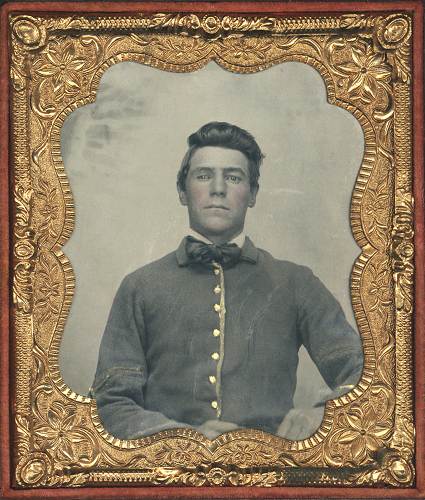
05 Andrew Bear 1840-1921
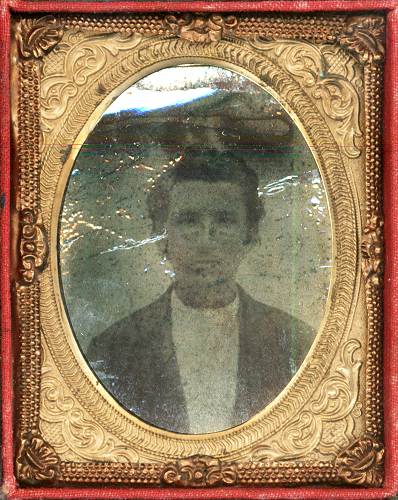
06 Absalom Bear 1842-1931
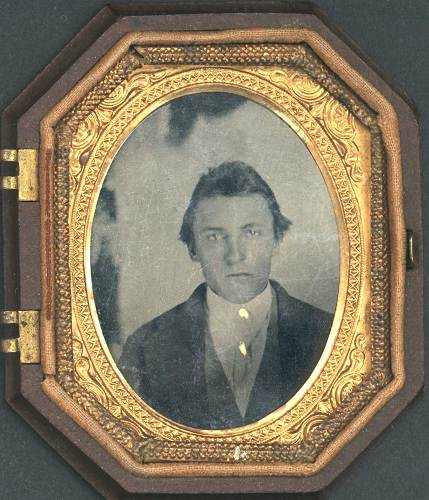
07 Madison Bear 1845-1882
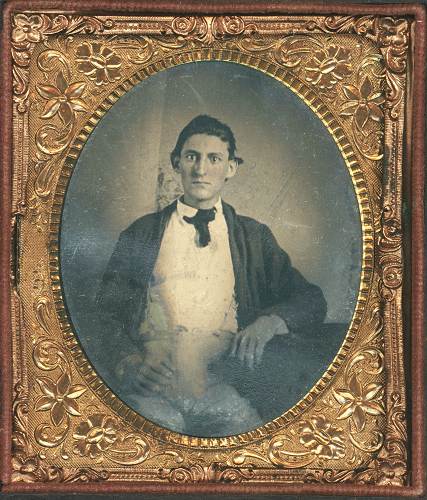
08 Simeon Bear 1848-1918
Patsy and Jill are working on a project to collect all the history they can find about the Civil War in Mid Missouri. Eventually, the information will be placed on the State Historical Society of Missouri’s website. The page dedicated to Miller County is not completed but you can review its progress at their website.
You can review the photos Patsy and Jill copied with more narrative detail at this page on our website.
Madison Bear was the grandson of George Bear, who brought his family to Miller County in 1857 (photos 09 and 10).
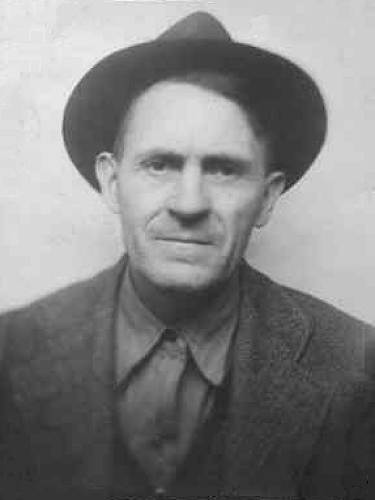
09 Madison Bear 1889-1971

10 George Bear 1806-1876
Madison orally presented the Bear family history to a reporter for the Miller County Autogram in 1953. Many of the people named in the article have by now passed away. Here is that story:
Miller County Autogram Sentinel
August, 1953
Bear Family Came To County in 1857
The history of the Bear family of Miller County, as related by Madison Bear of Tuscumbia, dates back to the pre Revolutionary War days when the first family immigrated to America from Switzerland. They settled in the colonies of Virginia and Pennsylvania. The earliest record available concerns Christian Bear, who was born in Gettysburg, Virginia, in 1762.
At the age of 14 or 15, he became a Colonial soldier in the Revolutionary War. However, he was not old enough to be an active fighting man, so he served in the musical department (probably the drum and bugle corps).
He was a mechanic by trade, which meant that he could do the work of a blacksmith and carpenter. His special skill was in cabinet making.
He was the father of a son, George, born in 1805. Later in life Madison moved with his family to Ohio, where he died.
George, son of Madison, also was a mechanic, but farming was his main occupation. He married Elizabeth Vogt, also of Switzer Dutch descent (photo 11).
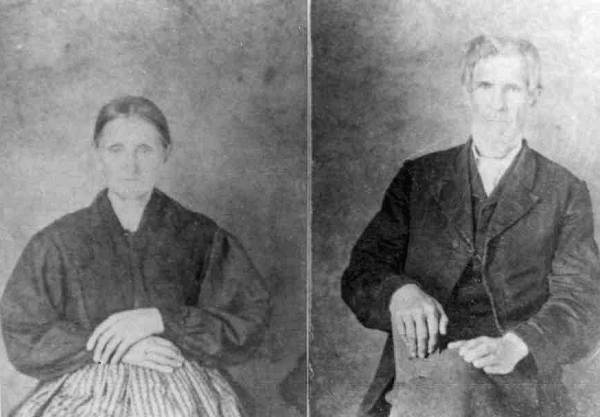
11 Elizabeth and George Bear
Being of sturdy pioneer stock, the Bear family moved westward to Missouri in 1857. The children were John, Henry, Madison, Andrew, Absalom, Simeon, George Jr., Benjamin, David, Catherine, and Polly. They were all born in Hocking County, Ohio, before the family moved to Missouri.
Note: See photos above of George’s sons. No photos are available of Benjamin, Catherine or Polly. The Madison Bear who was interviewed for this article was named for his uncle Madison, who was a brother to his father, David Christian Bear, son of George Bear, the patriarch of the family. George Jr. and David Christian Bear were too young to join their siblings in the Civil War. Here are their photos (photos 12 and 13):
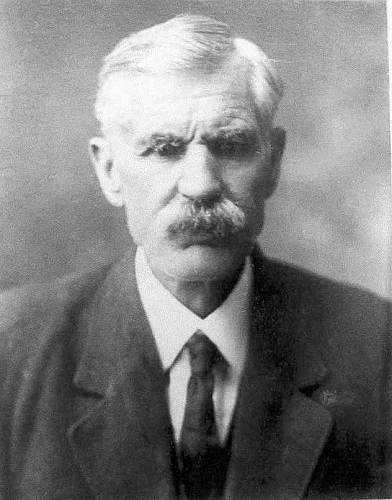
12 George Bear Jr.
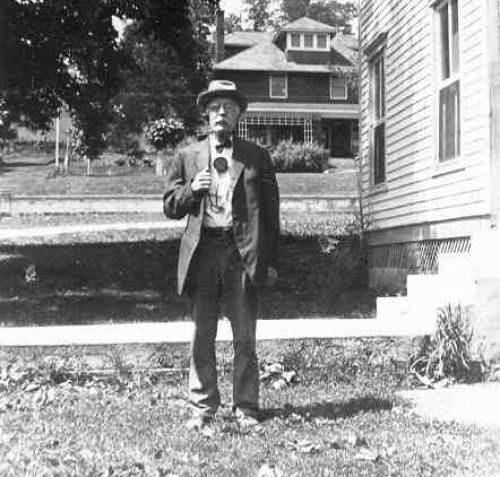
13 David Christian Bear
The family travelled by wagon to Cincinnati and by boat to St. Louis. As their occupation in Ohio had been farming, they came to Miller County and bought and entered a tract of land in Equality township. The property had few improvements, but the family set to work and soon developed a well improved farm near Dog Creek.
George lived there until his death in 1876, and his wife until her death in 1877. The land is still in the Bear family, and is owned by George William Bear, only son of Andrew Bear.
Note: Since this article was written both George William Bear and his son Roy Bear have passed away. The farm remains in the Bear family in the possession of Roy’s wife and son.
The sons of George Bear settled on farms in the same general area as the home farm.
Note: Here is a map circa late 1800’s which indicates the Bear properties south of the Osage River across the river from Tuscumbia (photo 14):
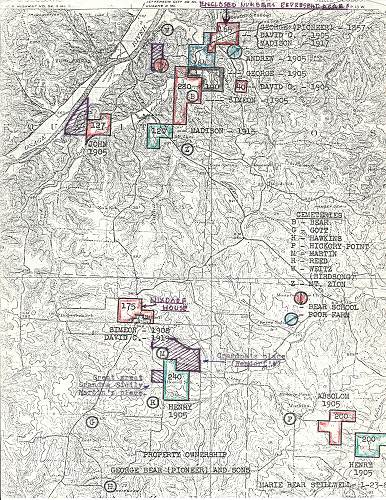
14 Bear Family Properties South of Osage River
Click image for larger view
George’s son John grew to manhood and received his education in Ohio. In 1861, four years after the Bear family arrived in Miller County, he enlisted in the Honor Guards and later enrolled in the Militia. He was in several skirmishes and was captured at Tuscumbia by the guerillas, but was soon released. A sergeant, he was mustered out in the fall of 1864. The same fall he was elected Miller County treasurer, serving two years, and in 1866, was elected county judge, serving 10 successive years.
He had married Laura Birdsong in 1859. They were the parents of John and Minnie. He later married Delilah Dobson and their children were Benjamin, Elizabeth, and Willie. Elizabeth is the mother of Ross and Garland Adcock of Tuscumbia and their sister, Mrs. Harvey (Mildred Smith) of Kansas City. Here is a photo of John Bear with other county officials sitting second from the left (photo 15); and a closeup of John from the same photo (photo 16):
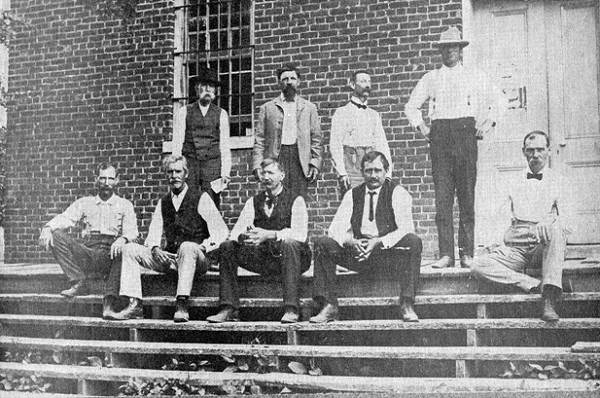
15 County Officials 1901 - John Bear - 2nd From Left Seated
Note: Here is the caption for photo 15:
Part of Miller County’s official family in 1901 poses on the front, or south, porch of the old brick courthouse. From left, sitting are John E. Kallenbach, treasurer; John Bear, probate judge; Joseph E. Lurton, presiding judge of the County Court; James Weaver, judge of the First District, County Court; and William M. Harrison, circuit clerk and recorder of deeds.
Standing, from left, are Billy Clark, deputy county clerk; George W. Payne, judge of the Second District, County Court; Charles H. Clarke, county clerk; and Anton Paul Nixdorf Jr. sheriff. According to Clyde Lee Jenkins, John Bear in the 1870’s, while presiding judge of the County Court, issued an order that the courthouse porch should be boarded up to keep Tuscumbia hogs from “roosting under it. (Picture courtesy of H.R. Adcock, Owensville, grandson of John Bear)
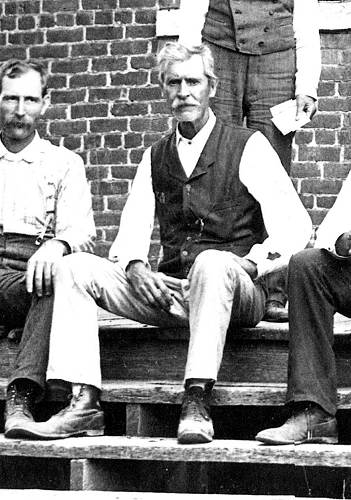
16 Judge John Bear
Henry Bear married a Miss Spearman. Their only daughter was Lucindy. After the death of his wife, Henry later married a Miss Robinson, who was the mother of Mrs. Charles (Eva) Umstead of Tuscumbia, Mrs. Robert (Dora) Mitchell of Alaska, and Annie and Olive, their sisters. By a later marriage to a Miss Livingston, he was the father of Willard and Lucy Bear (photo 17).
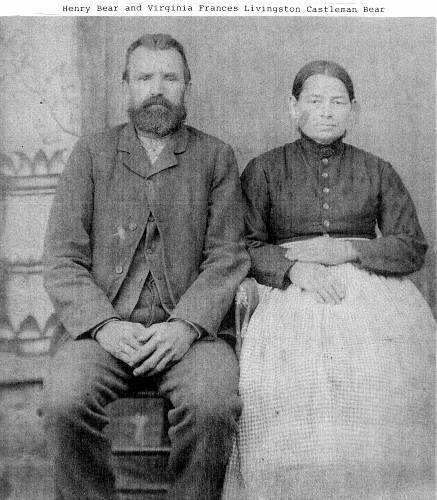
17 Henry and Virginia Bear
Andrew Bear was united in marriage to Cynthia Loveall, who died in 1950 at the age of 98 years. They were the parents of George William (Billie) Bear of Tuscumbia and Hester Bear Bennage (deceased). Andrew served with the Home Guards and Missouri Militia. He was mustered out at St. Louis in 1865 and returned to farming (photo 18).
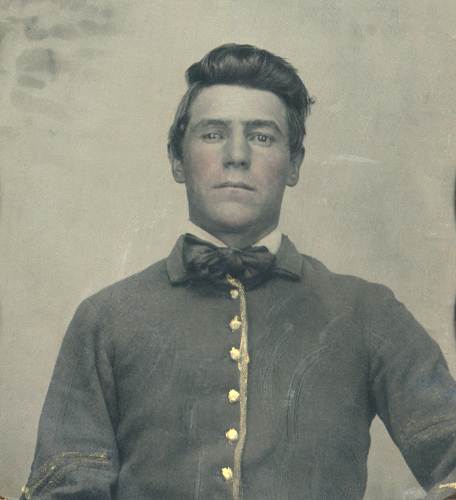
18 Andrew Bear 1840-1921
Before her death, Mrs. Bear told many interesting incidents occurring during the Civil War. She told of the struggle they had in keeping their home and property from being stolen or destroyed by the bushwhackers. Besides this, the Civil War was a fight between neighbors. Most of the people of this neighborhood, however, belonged to the Union Army, as did the Bear brothers. John, Henry, Andrew, Simeon, Madison and Absalom were veterans of the Civil War.
Simeon Bear married Louisa Cleveland, a cousin of President Grover Cleveland. Two children born to them died while very small (photo 19).
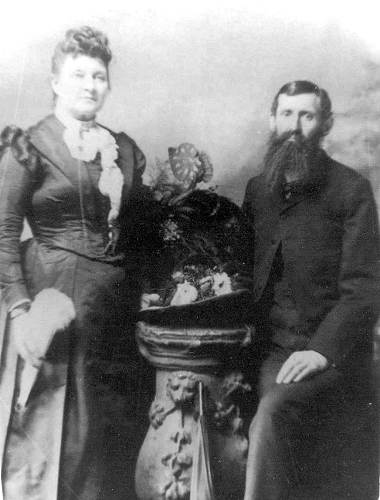
19 Simeon and Louisa Bear
Absalom Bear was united in marriage to a Miss Spearman. Their children were George, Zebedee, John, Frank, Martha, Nancy, Edna and Zella (photo 20).
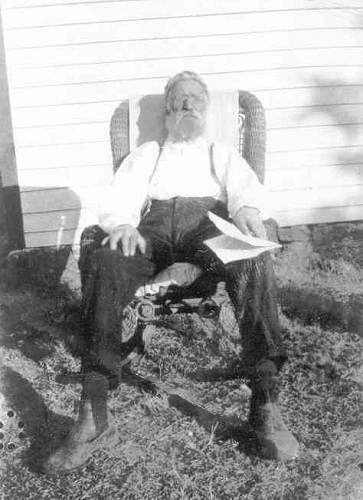
20 Absalom Bear
Madison and Benjamin were never married. The latter died at the age of 20.
Note: See photo 07 above of Madison. No photo of Benjamin is available.
George Jr. married Jennie Curry, daughter of Mr. and Mrs. Silas Curry, other early settlers of this vicinity. Their children were Henry, the late Mrs. Victor (Lydia) Nixdorf, Clarence Bear of Kansas City, Clyde Bear of Chicago, Mrs. L.Z. (Kathryn) Stark of Tuscumbia, Florence Franklin of Chicago and Ella Hamilton (photo 21).
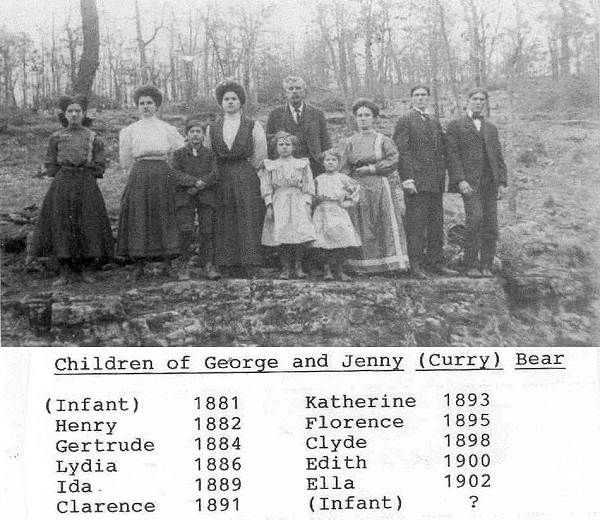
21 George Bear Jr. and Family
David Christian Bear married Mary Samantha Winfrey. Their children were Madison, who lives in Tuscumbia; Andrew, who died about 30 years ago; Christina (Mrs. Theodore Martin of Ulman, mother of Opal, Gertrude (Mrs. Robert Maylee of Eldon), and Frank); and Lucy, who married Phillip Hawk and after his death, married George Jewett; and Dora (Mrs. Ilde Wickham) of near St. Elizabeth (photo 22).
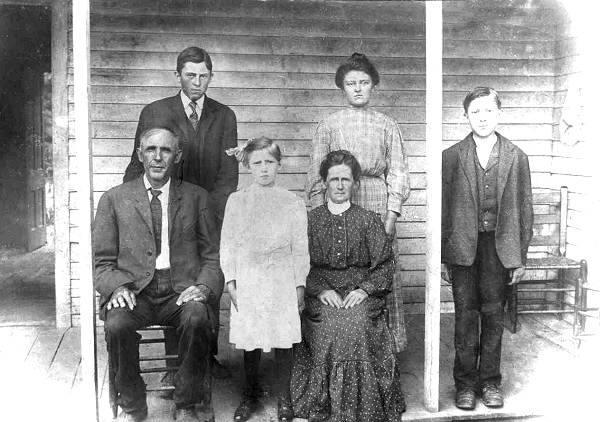
22 David Christian Bear Family - Front: David Christian, Dora, Mary and Samantha
Back: Madison, Lucy and Andrew
Being a staunch Republican family, many of the Bear family have held public offices. David Christian Bear was presiding judge of the County Court when the courthouse was rebuilt in 1910. Absalom Bear held the offices of county judge and state representative. John Bear was successful in political campaigns. Madison Bear (son of David Christian Bear and not the Madison who was David Christian’s brother) was elected county treasurer in 1942 and served for two consecutive terms. Frank Martin, son of Christina Bear Martin (daughter of David Christian Bear), held the office of county collector. He lived just above Tuscumbia on Highway 52.
Madison Bear of Tuscumbia was born three miles east of Tuscumbia on June 22, 1889. In 1908, he married Miss Sadie Abbett, daughter of Eli and Susie Abbett (photo 23).
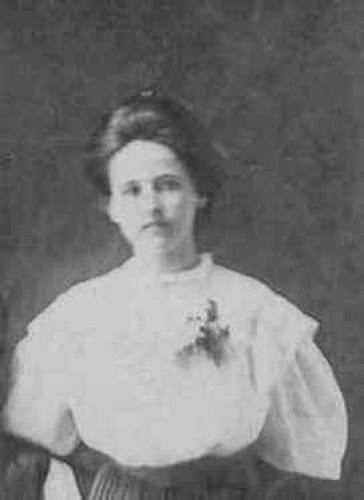
23 Sadie Abbett Bear
She was also of Pennsylvania Dutch descent. Their children are Arthur, who operates a grocery business in Eldon; Marie (Mrs. Robert Stillwell) of Alton, Illinois; David, who lives in Alton, Illinois; Susie (Mrs. Harold Pryor) of Tuscumbia; and Bonnie (Mrs. Wayne Tyler) of Eugene.
At several times in his life, Madison has operated business places both at Bagnell and Tuscumbia (photos 24 and 25).
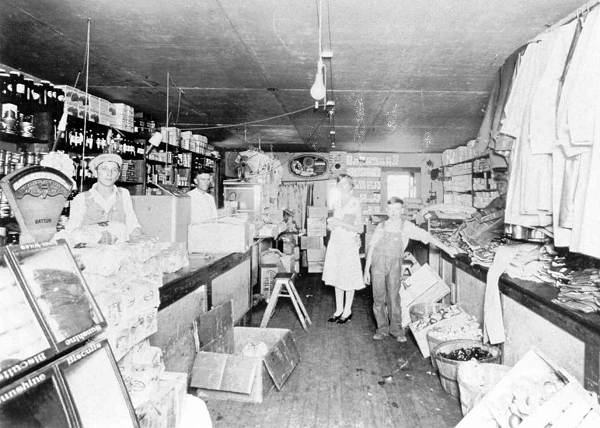
24 Madison Bear's General Store in Bagnell
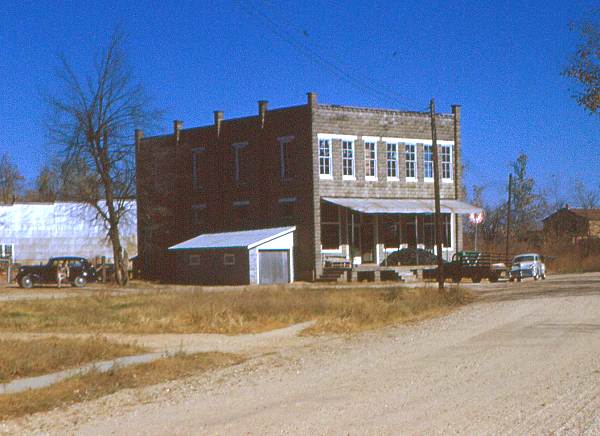
25 Madison Bear's General Store in Old Woodman Hall Building
The business in Bagnell, opened in 1929 while the Bagnell Dam was being built, burned in the early 1930’s after which Madison reopened another store in Bagnell at a different location. He was once manager of the Tuscumbia Farmer’s Exchange (photo 26).
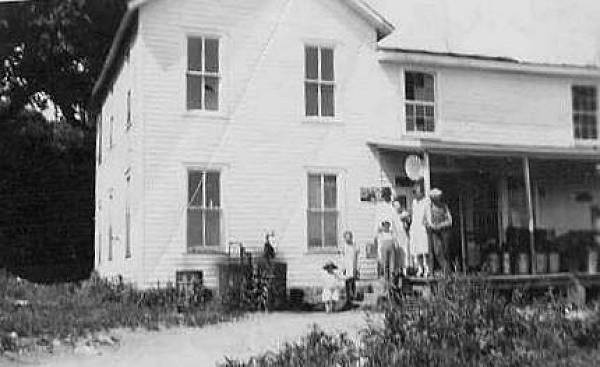
26 Farmer's Exchange Store - Gertha Wyrick second from Right
He is a member of the Mt. Zion Christian Church which his father, David Christian Bear and preacher Charles Sooter organized (photo 27).
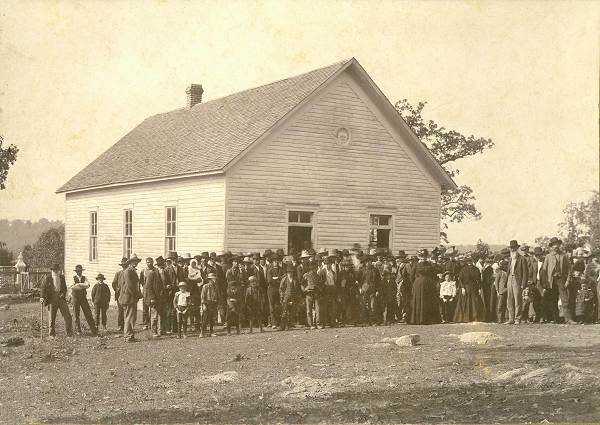
27 Opening Day of Mt. Zion Christian Church - 1901
George William Bear, son of Andrew Bear, is a prosperous farmer of Miller County, owning acreage on Dog Creek, south of town. This is some of the same acreage settled by pioneering members of the family.
He married Jennie Roberts, daughter of Monroe and Stella Roberts of Tuscumbia. They are the parents of a son, Roy Andrew (photo 28).
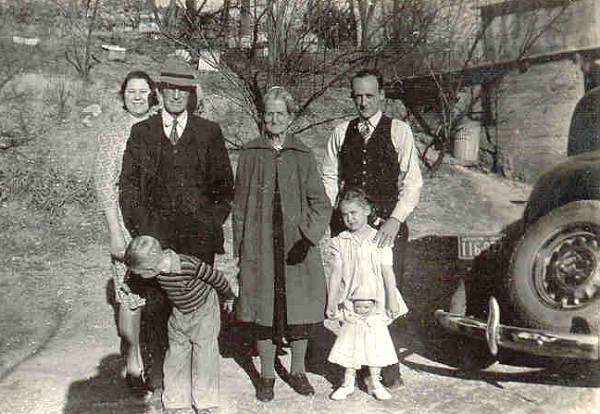
28 George Billie Bear - Jennie, wife behind George - Cynthia, mother of George on Left
Arthur Bear, Cousin - Roy Bear, son of George - Sandra Bear, daughter of Arthur
Note: Here is the caption for photo 28: George “Billie” Bear is on the left wearing a suit and hat. Behind him to his right is his wife, Jennie Roberts Bear. To George’s left is his widowed mother, Cynthia, wife of Andrew Bear. To the left of Cynthia is Arthur Bear, son of Madison Bear, who was a first cousin to George. The child in front of George is his son, Roy Bear; and the child in front of Arthur is his daughter, Sandra Bear.
Many family treasures kept by Madison’s mother burned with the farm home in 1949.
Mrs. Charles (Eva) Umstead, daughter of Henry Bear, resides on an Osage River farm south of town, with her son, Bill. Mrs. Umstead’s other children are Fred, who is a teacher in the Clarksburg, Missouri schools; Mrs. Clyde (Hazel) Humphreys of near Iberia; Mrs. Deane Leimkeuhler of Illinois; Carl Umstead of Texas and Mrs. Grace Farmer of Oklahoma.
Mrs. L.Z. Stark (Kathryn) and Mr. Stark live on their farm near Tuscumbia on Dog Creek. This is also one of the farms settled by her pioneering grandfather and great uncles. Mr. and Mrs. Stark have a son, Harold, who is a radio and TV announcer over station WBBM in Chicago.
Mrs. Victor (Lydia) Nixdorf, who died about 11 years ago was the mother of Homer of the state of California, Perry, who died a few years ago; Otis of Granite City, Illinois; Paul of Independence, Missouri; and Edith (Mrs. Ellis Livingston) of Deluth, Minnesota.
Many great great grandchildren of the first settlers have not been named but the family is very widespread. Their influence indeed had its part in the early history of Miller County.
Note: Here is a chart of the Miller County Bear family descendency compiled by Madison Bear’s daughter, Marie Bear Stillwell (photo 29):
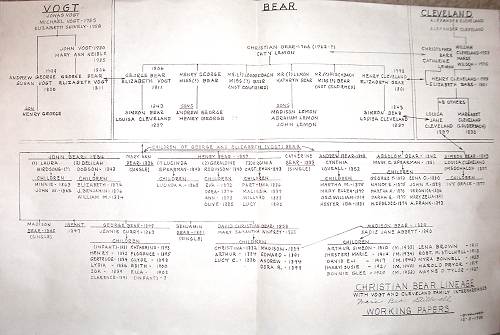
29 Bear Family Descendency
Click image for larger view
Since the above article was published in the Autogram in 1953, over time many of the Bear descendents have passed away or moved out of the county, especially during the years of the Great Depression in the early 1930’s.
As was noted above the Bear family was unusual in that so many of the sons served in the Civil War. Of George and Elizabeth Bear’s nine sons, six served as soldiers for the Union Army. These were the George Bear descendents in whom Patsy Luebbert and Jill Hartke were interested and the reason for which they visited our museum last week.
As mentioned above, you can read the details of their service records as well as other history about the family at this page on our website.
Peggy Hake has written many articles about the Civil War in Miller County. From her research she identified six significant “skirmishes” in our county during that period of time:
September 1, 1861 – Skirmish at Bennight’s Mill involving Missouri’s Home Guard.
August 29, 1862 – Skirmish near Iberia involving Missouri’s Enrolled Militia.
April 24, 1863 – Skirmish at Mill Creek Bridge involving a detachment of Missouri’s 24th Infantry and Missouri’s 1st Militia.
May 30-31, 1864 – Skirmishes at Mill Creek involving Missouri’s 9th State Militia Cavalry.
August 8, 1862 – Skirmish at Panther Creek involving Missouri’s 1st State Militia Cavalry and 2 sections of Missouri Artillery.
December 8, 1864 – Affair at Tuscumbia involving Missouri’s Brown’s Company Enrolled Militia.
To better understand the Civil War as it involved Miller County one first should read the following essay which gives the history of Missouri’s part in that conflict. Peggy Hake found this very good article about that subject which she reprinted in her book, Civil War In Miller County:
When the Civil War Started In Missouri
Fremont Days Supplement
Thursday, September 12, 1991 p.19
(As written by the Missouri Civil War Centennial Commission and the State Historical Society of Missouri, and published in the 19th Annual Magazine Edition of the Tipton Times, July 21, 1962)
Any understanding of Missouri’s part in the great Civil War must be based on what other states of the Union believed about Missouri and what Missourians felt about slavery and secession when the war began.
Since her foundation in 1821, Missouri had been a slave state, but, unlike her sisters to the South, she was bordered on three sides by free territory. She was called a slave holding peninsula jutting into a free soil sea. All of the irritations of a slave holding society almost surrounded by free people were exaggerated in Missouri, for in a true sense Missouri was a northern state settled by southern people, with southern customs and institutions.
As a result of her compromising geographic location Missouri’s Civil War and her identification as a strong Southern State began in 1854 with the passage of the Kansas-Nebraska Act by Congress. The Kansas Nebraska Act organized the two territories for settlement and declared that the legality of slavery in the states to be formed was to be determined by the people who would settle there.
At first glance this seemed a satisfactory arrangement for slave holding Missourians. It appeared natural that people of southern sympathies, especially Missourians, would flock into adjacent Kansas Territory and that the new state which would be formed would afford protection from the slave stealing Underground Railroad and provide no haven for runaway Negroes.
As soon as immigration into Kansas began in 1854, however, it became apparent to Missourians, especially to those who held slaves, that aggressive free soil interests in the north were also concerned over the settlement of the territory.
Eastern newspapers, goaded by abolitionist editors such as Horace Greely, sent reporters to the Missouri Kansas border and a wave of anti slavery, anti Missouri news stories and editorials filled their columns.
As a result of this inflammatory publicity, and the violence Missourians were soon to start in Kansas, many people of the North came to judge all the people of Missouri as “Border Ruffians” and “hellish slavers,” interested in expanding slavery throughout the entire West. Helping the Eastern abolitionist editors, authors and poets were the New England and allied Eastern emigrant Societies which were formed to move any voter to Kansas who would vote to make that state free.
As a result of such vigorous northern publicity, and the knowledge that some people were being moved into Kansas by the Eastern emigrant societies, the more radical pro slavery people of Missouri by the middle of 1854 felt they should take an active hand in determining what the government of the new territory should be.
The pro slavery leaders of Missouri declared a border war with Kansas. In 1854 and 1855 several thousand Missouri men rode into the territory and voted illegally in the elections which were held to elect a territorial congressional delegate and the territorial legislature.
These men were led by some of Missouri’s most prominent political figures, including Senator David Rice Atchison.
They came armed and did not hesitate to use force and intimidation at the Kansas polls. In both elections pro slavery candidates received handsome but very fraudulent majorities. This violent and illegal action by Missourians created further hysteria in the North.
In a short time the Territory of Kansas had two governments, one illegally elected and pro slavery; the other legal with a constitution prohibiting slavery. From 1855 until 1860 anarchy reigned along the Missouri Kansas border.
For five years armed Missouri mobs invaded Kansas and once occupied the capitol at Lawrence. Fights and murders took place in the territory and these disturbances were always identified with the slavery issue by newspapers in the North and South. Free soil Kansas, such as James H. Lane, James Montgomery, Charles R. Jennison, and old John Brown raised Kansas companies and raided into Missouri, killing men and freeing slaves.
Pro slavery Missourians who settled in Kansas were run out or murdered. In retaliation, gangs from Missouri hit back at Kansas with arson and looting and the territory gained the name “Bleeding Kansas”
The violence on the Missouri Kansas border was the start of the Civil War in the United States. Throughout the North, Missourians had gained the reputation of violent pro slavery, Southern people. The shrill debates over Kansas in the United States Congress, an intemperate Northern and Southern press, a willingness to ignore law, and a contempt for majority opinion had created a national belief that Missouri was solidly for the South. The Missouri Kansas frontier had become trained and conditioned to ugly civil strife.
Many Missourians had developed a feeling of hatred for what they considered abolitionist “Yankee Kansas.” In turn the Kansas tended to dislike all Missourians as meddlers and slavers. These seeds of hatred were to bear frightful fruit when war actually came. Then the Kansas Jayhawker of the 1850’s was to cloak himself with the power and authority of the Union and ride to Missouri. In payment, Missouri guerilla organizations were to arise to attack and punish Kansas. On both sides of the line men were waiting for the opportunity to take revenge for real and fancied wrongs that had happened in the five years before 1860.
Nationally, the South had come to consider Missouri as one of her strongest supporters, one of her most devoted sisters. The North shared that view, and when the state was occupied by out state troops during the war Missourians were to pay a heavy price for the intemperate, savage acts of a few men before 1861.
Here is Peggy Hake’s historical research about the Civil War in Miller County:
Miller County In The Civil War
Peggy Hake
Miller County, Missouri, established in 1837, was populated largely by southern pioneers during the era 1840-1860. Many families were slave owners, so naturally leaned toward the Confederacy. In the election of 1860, President Abraham Lincoln only received 23 votes in Miller County which strongly suggested the residents favored the southern cause.
During 1860 and 1861, mutterings were heard across the county and often discussions were heard at circuit court held at the courthouse in Tuscumbia. Strong speeches were given in defense of both the Union and for secession. As the weeks passed by, more meetings were held at the various settlements in the county… Tuscumbia, Iberia, Ulman’s Ridge and other places. The first rebel flag was hoisted high on a tree near Simpson’s store in Tuscumbia. At one time during the war, at the ferry landing in Tuscumbia, the rebel flag floated on the left and the national flag on the right of the ferry.
Note: During the time of the Civil War there were three different Confederate flags. Here is a photo of the first one (photo 37):
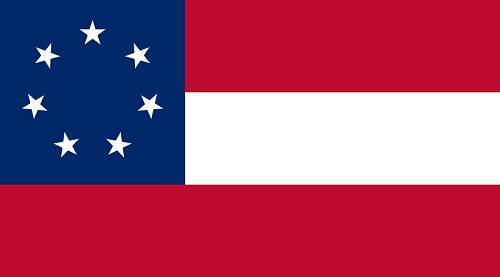
37 First Rebel Flag
You can read more about the flag of the Confederate States of America at this Wikipedia page.
Here is a photo of the Flag of the United States as it appeared in 1861 (photo 38):
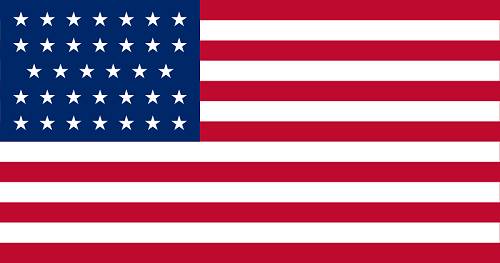
38 U.S. Flag - 1861
More about this flag and other variations can be found at this Wikipedia page.
As time went by, tempers flared: neighbor distrusted neighbor; and as one old timer once stated…”It turned into the roughest country on this earth.”
Among early companies organized during 1861, which were of Confederate sympathies, were Captain Abraham Castleman’s at Iberia in southern Miller County with his Lieutenant, Jesse W. Burks living east of Iberia; William Rankin Wright, who lived west of Iberia (photo 39); and Captain James Johnson at Tuscumbia.
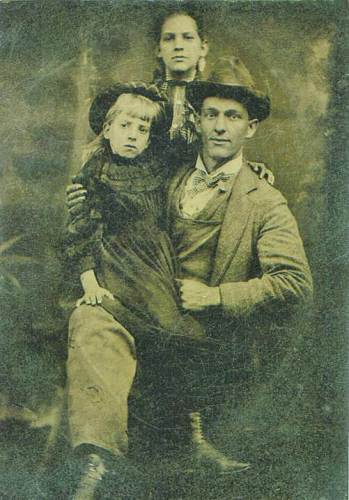
39 William Rankin Wright
Some of the early Union companies organized were Company K under Captain J.W. Canada; Company E under Captain Charles D. Martin (photo 40); Company D under Captain Benjamin Jeffries; and Company G under Captain W.A. Bradshaw.
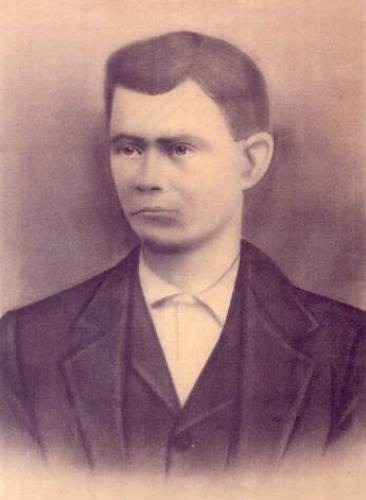
40 Charles Dather Martin
On June 10, 1861, at Camp Union near present day Brumley, these Companies met up with other companies and organized McClurg’s Osage Regiment with the following officers: Colonel J. W. McClurg, Lieutenant Colonel Emly Golden, Major J.K. Hall, and Major Kitchen (photo 41).
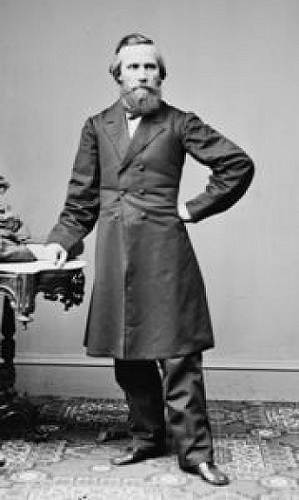
41 Joseph Washington McClurg
Golden and Hall were citizens of Miller County and the others from Camden County. Two Union companies were organized north of the Osage River, commanded by Captain Jacob Capps, Captain E.B. Rice, and Captain Thomas J. Babcoke.
At the beginning of the war, Miller County’s population was approximately 7000 people. It has been estimated that about 1000 men from Miller County took part in the Civil War and of these about 700 fought for the federal troops (Union) and the other 300 were with the Southern troops, often called “bushwhackers.” History tells us that many men who had leanings toward the Southern cause often joined the Union troops because they knew they would receive their pay vouchers each month. The Southern army was much poorer and did not always have the monetary means to support their soldiers.
There was actually only one battle that occurred in Miller County during the four years the Civil War raged across the country. It was fought on August 29, 1862 about four miles east of Iberia in southeast Richwoods township. It has been called “The Elsey Farm Fight,” held on land owned at the time by John and Rachel (Rowden) Elsey, a pioneering family from Roane County, Tennessee. A force of 42 Union men, under the command of Captain William Long (Company G Enrolled Militia), attacked a Confederate company. The southern troops (10th Missouri Cavalry from Shelby’s Brigade) were about 125 men strong under the command of Colonel Robert R. Lawther. The Union forces routed the larger Confederate group and they fled the scene. The Rebels lost one man with 3 injured and taken prisoner. The Union militia lost one man, John Levi Whittle. He died of mortal wounds to the lower extremities of his body.
Note: Whittle was the great great grandfather of Peggy Hake. You can read more about the “Elsey Farm Fight” at this previous Progress Notes.
One other atrocity happened in Miller County during the war…the massacre on Curtman Island. The Confederate guerilla, General Crabtree, pillaged, plundered, burned, and murdered all across central Missouri. He was headquartered in caves along the Osage River in northeastern Miller County. From there he sent his guerilla army out into the countryside to harass all the families in the area. The Curtman Island massacre happened in late August 1864 when his band of marauders bushwhacked a small scouting troop of Union militiamen who were resting on Curtman Island, located in the middle of the Osage River, not far from Crabtree’s cave.
Seven of the sixteen Union men were lined up on the small island and were shot, execution style. Some of the others escaped and returned back to their command post. The men executed were: Samuel McClure, John Starling, William Gibson, Richard Crisp, Nathaniel Hicks, Yancy Roark, and F.B. (Pharoah) Long, all residents or Saline township in northern Miller County. The bodies of the seven men, who died on that hot August day, were later recovered and given proper burials, most at the Allen Cemetery north of Eldon, Missouri. The United States government erected seven white military gravestones at the burial site of these Union soldiers.
Note: You can read more about the Curtman Island massacre at this previous Progress Notes and at this page about the Civil War on our website.
The end of the Civil War came in the spring of 1865, but it did not bring an end to old hatreds and animosities in Miller County for many years. As late as the early 1880’s, a shoot out occurred in Iberia which was brought about by old war memories. It seemed the violence would never end….
Thanks Peggy.
Through meticulous and tedious research Peggy Hake has identified many if not most of those Miller Countians who fought in the Civil War. You can scan that list on our website.
Many Miller County families can recount stories of their ancestors’ involvement in the Civil War. One of these stories is about the Williams family of Iberia. Several years ago, Sue Steen Cates, a descendent of John Williams Jr. researched the history of the Williams family. One of the stories she recorded was typical of many other families revealing the hardships faced during the Civil War as well as the occasional intrafamily feuds and disagreements which were evoked by the conflict. I have condensed and reworded some of the story from Sue’s book, How Do I Fit In for presentation here:
About six miles west of Iberia on the south side of Highway 42 a small road sign can be seen which reads “Williams Road.” The road is the entry to a large farm now owned by Greg Lee but which many years ago in 1859 was settled by John Williams Jr. and his family who came here from Kentucky. John was a slave owner in Kentucky and had brought with him one female slave and her daughter as well as his ten children. When the Civil War began, John and two of his sons, Wade Alexander and Bluford Barton left home to join the Confederate States Army with the goal of taking back the State of Missouri from the Union. Although John the father survived, his two sons were killed. Bluford died in the battle of Baker’s Creek near Vicksburg, Mississippi, May 16, 1863. He was twenty years old. A mass grave was the burial place for those that were killed in the battle.
Wade died in the Battle of Franklin, Tennessee…just south of Nashville. His grave is in the McGavock Confederate Cemetery near the battle site (Also known as Klinkenbeard Cemetery). He was 27 years old. He left a little boy back at the Iberia farm, Ben, who was also without a mother as she had died a year earlier.
However, unknown to John Williams Jr., another son, John Riley, had joined the Union Army but died of disease. After the war, because of continuing conflict, John Williams Jr. had been forced to flee to Arkansas where he stayed for a couple of years before returning to Miller County. It was then that he learned of the death of his three sons. However, he was mightily relieved to find that his six daughters and one son Ben had remained on the farm.
Many descendents of the William’s family remain in our county and elsewhere who gather annually at the Williams Cemetery located on the home farm to honor their ancestors who are buried there. The family has preserved a photo of Wade Alexander Williams, a copy of which is on display at our museum (photo 42).
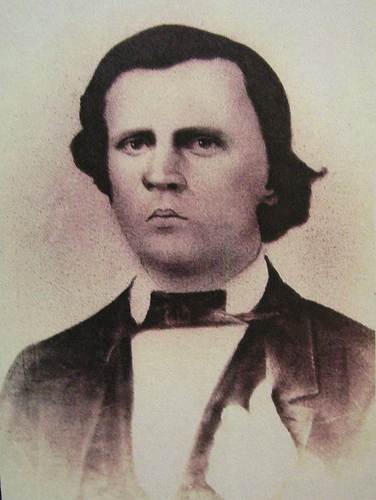
42 Wade Alexander Williams
Confederate Soldier killed in Franklin Co., Tennessee - November 1864
Ben Williams was the only male survivor of the family; however, a number of his descendents live in the Miller County area, some of which have retained the Williams surname. And even more Williams’ descendents live here who have other surnames being descended from the daughters of John Williams.
You can find a more detailed account of the Williams family story written by Williams’ descendent Nancy Thompson on our website.
A very personal account by Sue Steen Cates of her meeting with some of the Williams’ family African American slave descendents which includes more information about the Williams’s slave cabin can be found at this previous Progress Notes.
Especially important to us is the gift to our museum campus by the Williams’ family descendants of the original slave cabin which was home to the two slaves John Williams Jr. brought with him to Miller County (photo 43).
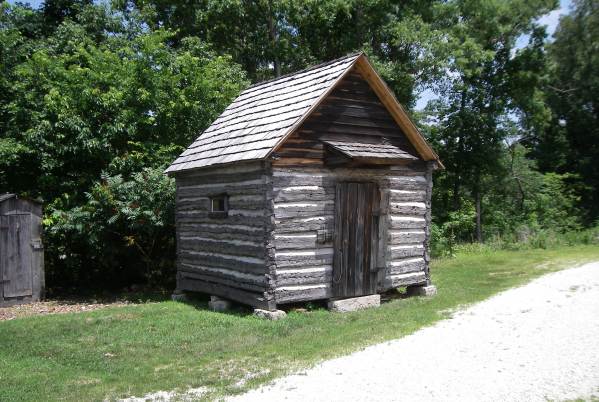
43 Williams Slave Cabin
Recently, Shawn Kober of LakeTV Channel 24 came by for a visit to our museum and was kind enough to shoot some film with our narration about the museum and its exhibits. Myself and Harold Flaugher gave him a tour which you can watch here (Note: In the narrative of the video I should clarify one statement I made; the first white settler of the county was William West near the Big Tavern in 1807. The Harrison Brothers, James and John, were the first known white settlers of Tuscumbia in the early 1830’s):
That’s all for this week.
 Joe Pryor
Previous article links are in a dropdown menu at the top of all of the pages.
|

